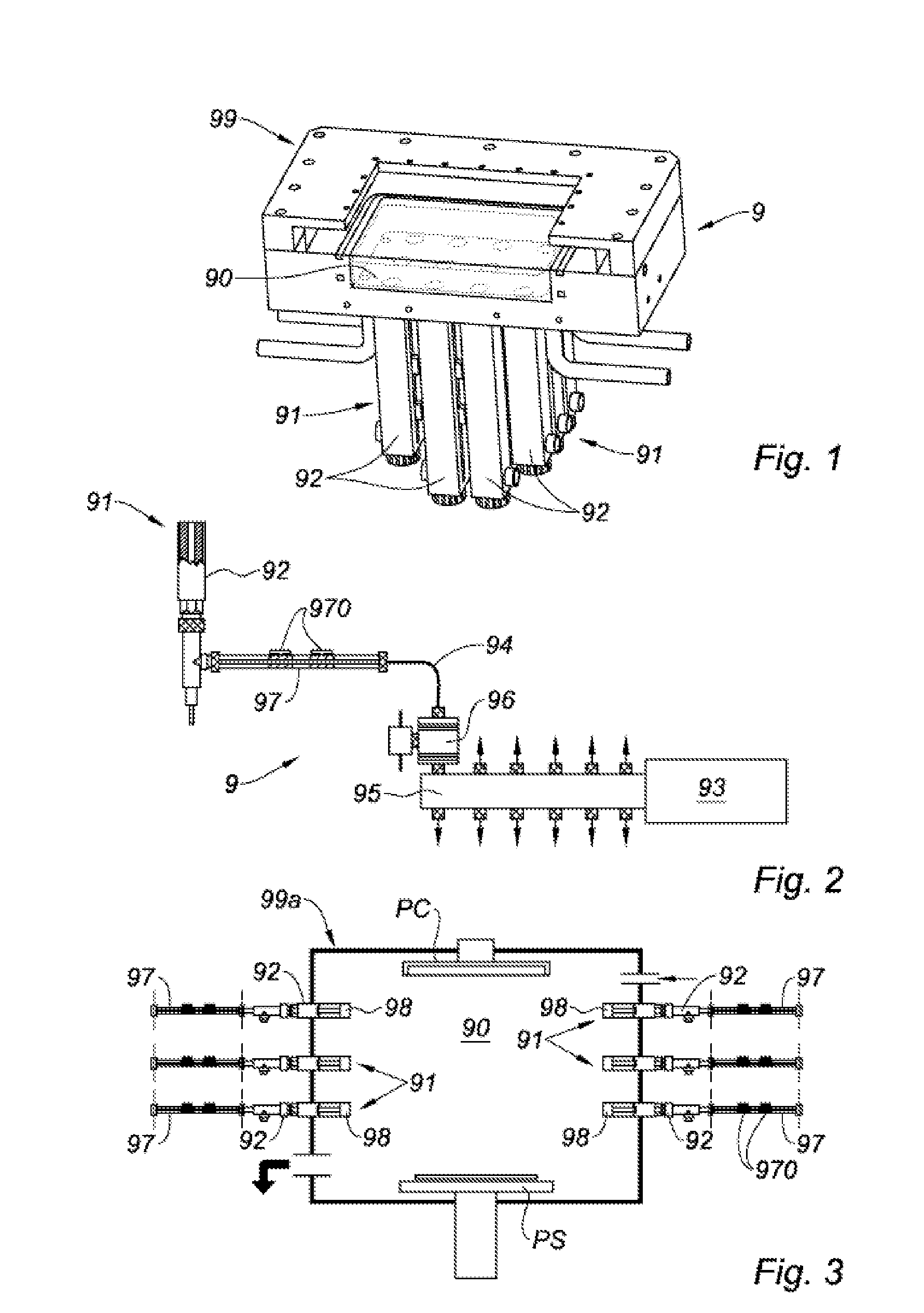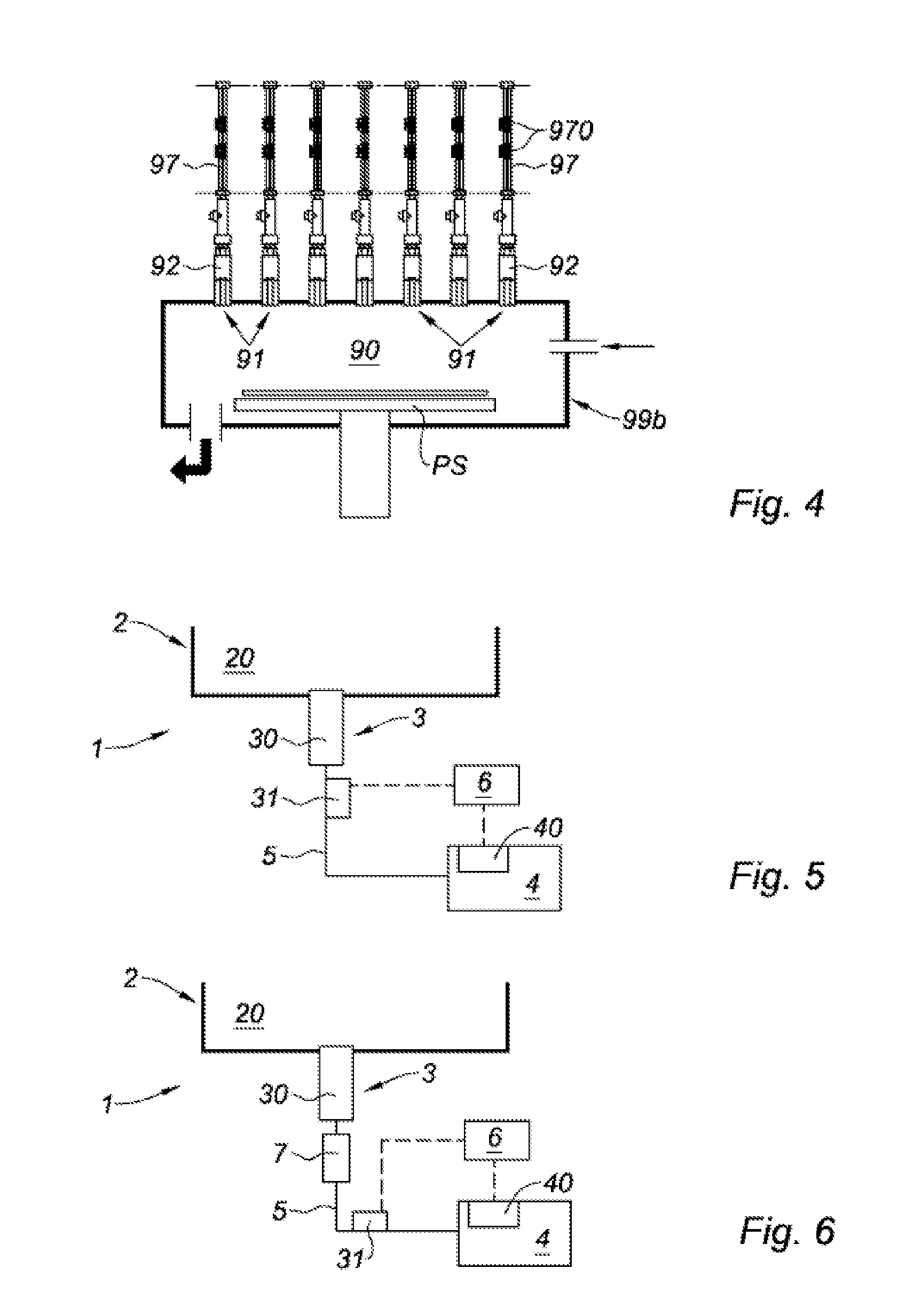Facility for microwave treatment of a load
a load treatment and load technology, applied in microwave heating, electric heating, electric/magnetic/electromagnetic heating, etc., can solve the problems of complicated and restrictive impedance matching, limited impedance matching devices, and high cos
- Summary
- Abstract
- Description
- Claims
- Application Information
AI Technical Summary
Benefits of technology
Problems solved by technology
Method used
Image
Examples
first embodiment
[0158]In the invention illustrated in FIG. 5, the plasma production facility 1 includes:
[0159]a reactor 2 having a treatment chamber 20 in the volume of which the plasma is produced;
[0160]an elementary plasma source 3 comprising an application device 30 applying an electromagnetic wave in the microwave range to the inside of the treatment chamber 20, as well as a measurement system 31 for measuring the power reflected by the application device 30;
[0161]an electromagnetic wave generator 4 in the microwave range, of the solid-state type, connected to the application device 30 by means 5 for guiding the electromagnetic energy, the generator 4 comprising a frequency adjustment system 40 designed to adjust the frequency of the wave between approximately 2400 and 2500 MHz, or even in another predetermined frequency range; and
[0162]a controller 6 connected at the input to the measurement system 31 and at the output to the frequency adjustment system 40.
[0163]For the rest of the description...
third embodiment
[0202]In the invention illustrated in FIG. 7, the plasma production facility 1 includes:
[0203]a reactor 2 having a treatment chamber 20 in the volume of which the plasma is produced;
[0204]several elementary plasma sources 3 each comprising an applicator 30 inside the treatment chamber 20 applying an electromagnetic wave in the microwave range, as well as a measurement system 31 for measuring the power reflected by the corresponding application device 30;
[0205]an electromagnetic wave generator 4 in the microwave range, of the solid-state type, connected to the applicators 30 by coaxial cables 5, the generator 4 comprising a frequency adjustment system 40 designed to adjust the frequency of the wave between approximately 2400 and 2500 MHz, or even in another predetermined frequency range; and
[0206]a controller 6 connected at the input to the measurement system 31 and at the output to the frequency adjustment system 40; and
[0207]a power divider 8 placed at the output of the generator 4...
sixth embodiment
[0221]In the invention shown in FIG. 10, the plasma production facility 1 includes:
[0222]a reactor 2 having a treatment chamber 20 in the volume of which the plasma is produced;
[0223]several elementary plasma sources 3 each comprising an applicator 30 inside the treatment chamber 20 for applying electromagnetic waves in the microwave range, as well as a measurement system 31 for measuring the power reflected by the corresponding application device 30; and
[0224]several electromagnetic wave generators 4 in the microwave range, of the solid-state type, each connected to an applicator 30 by a coaxial cable 5, with one generator 4 per elementary source 3, each generator 4 comprising a frequency adjustment system 40 designed to adjust the frequency of the wave between approximately 2400 and 2500 MHz, or even in another predetermined frequency range; and
[0225]a controller 6 connected at the input to the measurement systems 31 of the different elementary sources 3 and at the output to the f...
PUM
 Login to View More
Login to View More Abstract
Description
Claims
Application Information
 Login to View More
Login to View More - R&D
- Intellectual Property
- Life Sciences
- Materials
- Tech Scout
- Unparalleled Data Quality
- Higher Quality Content
- 60% Fewer Hallucinations
Browse by: Latest US Patents, China's latest patents, Technical Efficacy Thesaurus, Application Domain, Technology Topic, Popular Technical Reports.
© 2025 PatSnap. All rights reserved.Legal|Privacy policy|Modern Slavery Act Transparency Statement|Sitemap|About US| Contact US: help@patsnap.com



